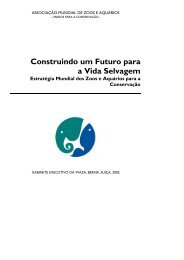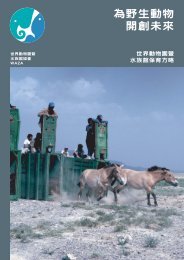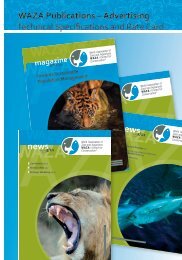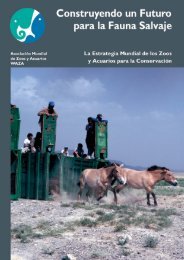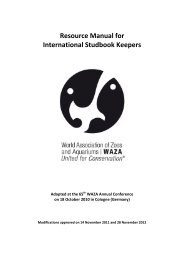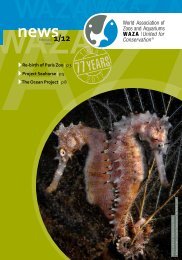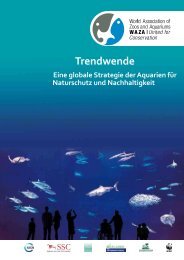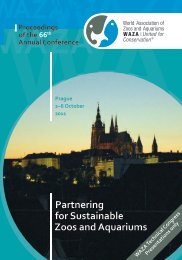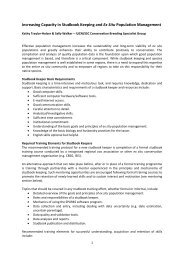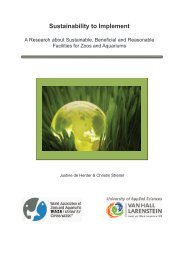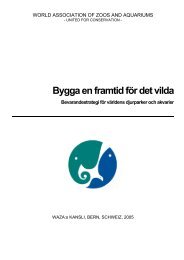Towards Sustainable Population Management - Waza
Towards Sustainable Population Management - Waza
Towards Sustainable Population Management - Waza
Create successful ePaper yourself
Turn your PDF publications into a flip-book with our unique Google optimized e-Paper software.
WAZA magazine Vol 12/2011<br />
Recommendations<br />
If zoo populations are not sustainable,<br />
neither are zoos themselves. Too few<br />
populations are currently satisfying<br />
the conditions for sustainability.<br />
There is scope for reversing this trend<br />
but it requires renewed commitment<br />
and new investment. The following<br />
five-point plan summarises steps that<br />
could be taken towards this end.<br />
Step 1: Global Audit. A complete audit<br />
of WAZA populations to provide<br />
a useful snapshot of potential, for use<br />
in planning.<br />
Step 2: Global Planning. An inclusive<br />
process, based on the audit, to identify<br />
a list of priority species for global<br />
management, based on population<br />
potential as well as wild status.<br />
Step 3: Global Targets. Calculation<br />
of global target population sizes for<br />
each priority species, based on appropriate<br />
science and a rationale of<br />
sustainability:<br />
• All taxa categorised by IUCN as Extinct<br />
in the Wild or Critically Endangered<br />
should be assigned a target<br />
N e of 500 (700 < N < 1,900).<br />
• All other taxa for which recruitment<br />
from the wild is considered inappropriate<br />
or impossible should also be<br />
assigned a target N e of 500.<br />
• For taxa where recruiting new<br />
founders is not considered inappropriate<br />
or impossible, an N e of<br />
120 (170 < N < 460) should be the<br />
target, in conjunction with the input<br />
of around five new founders each<br />
generation.<br />
• Exceptions to this could be: taxa<br />
being deliberately phased out, taxa<br />
present for short-term research or<br />
breed-for-release programmes and<br />
taxa for which there are established<br />
gene banks that allow gene<br />
diversity targets to be met at lower<br />
numbers (noting that demographic<br />
considerations should dictate the<br />
minimum number in such cases).<br />
Step 4: Global Investment. Appropriate<br />
investment in professional species<br />
managers, husbandry innovation<br />
and supporting technology. This<br />
will help ensure that science-based<br />
targets are set and that programmes<br />
are designed and managed to meet<br />
those targets at achievable population<br />
sizes.<br />
Step 5: Global Commitment.<br />
Long-term programmes require<br />
long-term commitment. Mechanisms<br />
for securing this commitment from<br />
participating zoos should be factored<br />
into industry benchmarking and accreditation<br />
programmes.<br />
Sustaining the viability and genetic<br />
value of zoo populations requires<br />
larger, better founded and more<br />
imaginatively managed populations<br />
than we often have at our disposal.<br />
A concerted move away from<br />
regional and towards global coordination<br />
of genetic and demographic<br />
management has the potential to<br />
dramatically improve the quality of<br />
captive resources available to support<br />
wild populations of many species.<br />
Fully mobilising that resource will be<br />
challenging, but must be a priority<br />
for the world’s zoos over the coming<br />
decade.<br />
References<br />
Global Sustainability 5<br />
• Frankham, R., Ballou, J. D. &<br />
Briscoe, D. A. (2002) Introduction<br />
to Conservation Genetics. Cambridge:<br />
Cambridge University<br />
Press.<br />
• ISIS/WAZA (2005) Studbook Library<br />
CD-ROM. Eagan, MN: ISIS.<br />
• Lacy, R. C. (1987) Loss of genetic<br />
diversity from managed populations:<br />
interacting effects of drift,<br />
mutation, immigration, selection,<br />
and population subdivision. Conservation<br />
Biology 1: 143–158.<br />
• Lees, C. M. & Wilcken, J. (2009)<br />
Sustaining the Ark: the challenges<br />
faced by zoos in maintaining<br />
viable populations. International<br />
Zoo Yearbook 43: 6–18.<br />
• Willis, K. & Wiese, R. J. (1993)<br />
Effect of new founders on retention<br />
of gene diversity in captive<br />
populations: a formalization of<br />
the nucleus population concept.<br />
Zoo Biology 12: 535–548.



